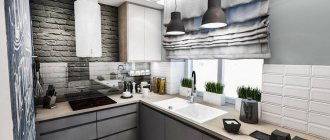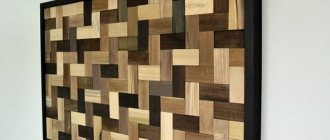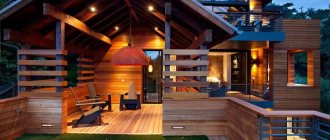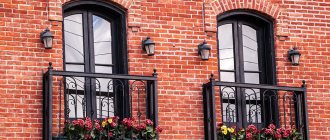A kitchen without upper cabinets is suitable for decorating rooms with a focus on different designs. At the same time, the environment should be comfortable. For this purpose, it is necessary to take into account all possible design recommendations, as well as consider various ideas for organizing useful space. After all, if there is no hanging set, there will be less space for storing dishes.
Laconic kitchen without unnecessary details Source rerooms.ru
Pros and cons of a kitchen without upper cabinets
Before deciding to introduce such an innovation, you need to weigh the pros and cons.
Of course, not every housewife can decide to voluntarily give up half the space for storing dishes, dry foods, utensils and other items. And this is the main disadvantage of a kitchen without wall cabinets. But is it really that bad?
First, about the benefits.
- The interior becomes lighter , more air appears, and the space is optically enlarged.
- The workspace does not need additional lighting, especially if you place it near a window using a window sill. There are many possibilities for planning.
- There is no risk of plaster and heavy cabinets collapsing (this can happen if the walls are not strong enough, for example, made of foam blocks, or if the furniture is poorly secured).
- Owners and guests will stop banging their heads on rickety furniture.
- Improved hygiene. A room with more light looks visually cleaner and fresher.
- You can decorate the apron up to the ceiling , hang open shelves and decorate them with original decorative elements, such as dishes, ceramics, live plants in pots, etc. A free wall gives room for creativity.
- All storage facilities are located in the lower cabinets . Arrange a full-fledged dining area with built-in drawers and shelves for utensils. This is great for short people who are tired of having to prop up a bench to reach things. Storage space becomes more accessible for people of all sizes and ages. However, some drawers, such as those containing sharp objects, may need to be kept away from children.
Furniture manufacturers recommend pantries or columnar cabinets, but sideboards have made a comeback as a modern trend.
These spacious designs look beautiful and can be a great place to store cutlery, crockery, coffee/tea sets, glassware, jam/juice jars and other useful items.
The disadvantages are as follows.
- It is difficult to think of other storage options to replace wall cabinets in small kitchens - they are a very practical option, so it is not recommended to abandon them in small apartments. And they add a lot of usable space by freeing up the floor. Studios are a different matter. The room is level with the kitchen allowing you to experiment with the interior.
- Open shelves used to decorate a free wall will quickly become dusty. Dust will also accumulate on objects placed on them. This will increase the time required for cleaning.
- The storage system will be located at the bottom , so you will often have to bend down to take out or put down an item.
- There is a huge free wall that needs to be decorated somehow. Of course, it will get dirty when using the stove, sink and will require additional cleaning.
If you consider the disadvantages, they can easily be turned into advantages, and this applies to rooms of any size.
Use open shelves
Kitchens with open shelves look minimalistic, in the spirit of Scandinavian style.
However, they are not practical for everyone.
Open spaces are the first to collect dust and create clutter.
But if you approach the idea with enthusiasm and keep it clean, then a kitchen with open top shelves will look neat and stylish.
What layout to choose for a kitchen without upper cabinets
There is no difference between a two-story and one-story kitchen. You have the same four options: corner, U-shaped, linear and island.
A corner kitchen is a convenient, functional and rational solution for space planning. The floor blocks installed in this case have an angular configuration. Floor and column cabinets can also be installed in corners along walls.
This way of arranging furniture easily creates a classic work triangle with a sink, stove and refrigerator. A corner cabinet is also ideal for kitchens of any size, especially small ones.
It is also a much cleaner option as it keeps dust and grime out of the upper cabinets.
Simple kitchens are also known as linear kitchens. All base cabinets are located on one wall. There is a refrigerator next to the countertop, and next to it is the cooktop and sink.
Linear layout is ideal for narrow kitchens. Without upper cabinets, the room will look larger and brighter.
If you are thinking about storage, then all the food and utensils can be placed in the lower section.
A U-shaped kitchen, where all the base cabinets are located along three walls, makes it easy to create a useful triangular work area.
It also has plenty of space to store utensils even if the upper cabinets are inaccessible. However, the U-shape can only be used in a medium to large sized kitchen. You shouldn't do this in a small room.
A large kitchen requires a special approach to its layout in order to make it beautiful and ergonomic.
A kitchen with an island is a layout where the main work surface is in the center of the room. An island can include a cooktop, a burner, an oven, a sink, a dishwasher—there are many possible configurations.
An island also allows you to free up wall cabinets without compromising the functionality of the kitchen. However, this type of layout is only suitable for spacious rooms with an area of at least 20 square meters. m.
When all surfaces in the kitchen are open, it is important to maintain perfect order and cleanliness.
What about technology?
Large ones - a refrigerator, washing machine and dishwasher - are placed on one wall or in the corners, and small ones are hung. Small equipment includes:
- microwave oven,
- hob,
- coffee machine,
- small single-compartment refrigerator.
A hanging kitchen is still a non-standard solution, and due to its high cost, not many people can afford it. But when choosing such a headset model, the owners will appreciate it. The main thing is to calculate everything correctly, think through the style, shades and overall weight of the structure. If a hanging kitchen still seems unreliable, it is better to give preference to a floating one.
How to replace upper cabinets
To compensate for the lack of memory, you can use the following options:
- Wardrobe with columns. Suitable for large spaces. Ideal for cabinets opposite or on either side of kitchen cabinets. You can also build large household appliances into the cabinet, such as a washing machine, refrigerator, dishes, kitchen and food utensils.
- Install a sideboard, buffet, bookcase or closet to match the color and style of your kitchen. Suitable for small spaces. They do not require the creation of an entire wall. A big plus is the shelves, behind which you can beautifully arrange tableware, figurines, and favorite souvenirs to decorate and highlight the taste of the hostess.
- Open shelves. An ideal addition to any Provence style interior. Ideal for storing food and drink sets, kitchen utensils and spice jars. They are usually installed in conveniently located places, for example, above the sink, kitchen countertop or across the entire width of the wall in a chaotic manner.
- Rails. These are open shelves made of lighter material - metal. They can be used to place storage items, hang towels, handles, spatulas, kitchen gloves and accessories.
A corner cabinet model without extensions on one side is also available. Hanging cabinets provide storage without cluttering the space.
What to attach a wall-hung kitchen to?
The usual bolts and screws used to assemble a standard kitchen are not enough in this case. Hooks are also not suitable, as they will not allow you to properly adjust the lower drawers of the headset. Hanging kitchens are most often installed on:
- reinforced corners - one metal corner can withstand a weight of up to 120 kg, for each module you will need 2-4 of these. It is important to correctly calculate the total weight, including the future filling of the cabinets, in order to ideally position all modules at the same height;
- rails - relevant when placing cabinets along the entire wall. In addition to the rails, fasteners for standard kitchens are used;
- mounting profile - in this case the wall is pre-leveled. Canopy hooks are attached to the profile to hold the modules. The height of all cabinets is adjustable using a profile, which simplifies the alignment task.
Main problems in practice
Home owners and interior designers face many challenges. These are the main disadvantages of kitchens without upper cabinets:
- Significantly reduced storage space. Utensils and utensils must be moved to other rooms and systems.
- Not all furniture and electrical appliances can be installed in such a room. Often, hanging units are used to store a gas water heater, utility systems, electrical wiring and packaging.
- A blank wall needs repair and additional decoration. In the case of new apartments this is not a problem, but in the case of used apartments it is a completely different matter. In such cases, large-scale renovations should be carried out using a good design plan.
Each case should be approached with special attention, exploring all possible options for layout, lighting and furniture organization.
Creating a unified style for the kitchen space
Well-chosen interior elements will create a harmonious interior
For those entering the kitchen, the first visual impression is a fragment of the wall above the level of the countertop, so designers are always concerned with decorating it, placing on it a special screen (apron) made of a variety of materials.
Installing an apron
The function of the screen is broader than just the aesthetic transformation of space; it protects the wall from all surprises that arise during the cooking process (splashes, fumes, high temperatures), and is constructed of surfaces that ensure ease of maintenance. The protective screen must resist the effects of water and the aggressiveness of household chemicals, since hygiene requires frequent use.
The combination of functionality and decorativeness is the main advantage of this kitchen element, therefore the following are preferred as its basis:
- ceramic tile;
- triplex (tempered glass), often acquires a decorative surface during the production process;
- polished metal;
- porcelain stoneware;
- fake diamond;
- laminated MDF panels;
- PVC plastic;
- linoleum.
Kitchen countertop diagram.
The dimensions of the kitchen “apron” depend on the size of the working surface of the countertop and have a height of 60-80 cm; it can be a solid panel or consist of fragments, edged with moldings or secured with brass screws. Read how to choose an artistic kitchen panel made from MDF using this link.
In order to achieve a decorative effect, it is illuminated or, if the material is transparent, a base substrate with a print is used, or, as an option, photo printing on the surface.
Kitchen without upper cabinets in various styles
Classic style
When decorating a classic kitchen, designers recommend focusing on natural materials. Kitchen cabinets can be made from natural wood.
For a budget option, consider chipboard or MDF.
The walls are decorated with washable wallpaper with small patterns. The photo of a kitchen without cabinets in a classic style shows an interesting combination of wooden surfaces with the texture of natural stone and ceramics. The windows in the room are decorated with light curtains.
- The dining room should be well lit.
- Above the dining area is a pendant chandelier with crystal elements.
- For additional lighting, you can use wall lamps.
Brickwork
Great idea for a loft, Scandinavian interior.
Loft. Brick can be bright and rustic to add a rugged feel. Light brick finishes are best suited for a Scandinavian style kitchen.
Other styles in which brick finishing looks good are country, Provence, and shabby chic. In Provencal or vintage style, the bricks should be lighter, without sharp color contrasts.
High-tech and Minimalism
Modern style is good because it allows you to make non-standard decisions without regard to traditional methods of interior design. Designers advise using a minimum amount of furniture in this interior. There is simply no need to buy upper cabinets.
The room remains light, airy and minimalist. The finishing materials most often used are plastic boards, chipboard, metal, porcelain stoneware and artificial stone.
Modern
A room decorated in this style is a work of art. It is characterized by high gloss, regular and strict geometry, the use of metal, glass and even plastic.
The lighting is accentuated: there should be a large chandelier and several single lamps, sometimes with LEDs. There are no color requirements - you can even use black.
Country
A pleasant rural style that will give a feeling of nature even to people living in a metropolis. Provence is an integral part of:
- natural materials;
- rustic and simple finishes;
- calm color scheme.
In country style, it is easy to do without extensions, replacing them with shelves made of thick wooden boards.
Art Deco
Luxurious style for those who love classics. Most often used in large apartments and country houses, where the kitchen is combined with a dining room.
Only the most expensive materials are used: mahogany, silk, leather, crystal. There should be stucco and patterns on the walls.
If you remove the top set, then in its place there should be only paintings - this style does not like open shelves.
A kitchen without wall cabinets is an excellent solution that will give the room originality and lightness. It can be integrated into any interior. Experiment - this is the only way to get a kitchen that will delight you for many years!
Loft style
A kitchen without cabinets is an ideal solution for a loft style. Metal shelves on the walls are a great alternative.
The upper cabinets will not block large windows, so the room will be filled with light.
The interior design uses brick, concrete, natural wood, metal and glass.
Provence style
Photos of kitchens without wall cabinets in the Provence style reflect the beauty of the rustic style. The walls are usually painted in milky shades.
Flowers in ceramic vases are placed throughout the room, and the windows are decorated with chiffon curtains.
- For this soft, romantic style, the kitchen is beautifully designed without cabinets.
- There are many shelves to store interesting decorations and kitchen utensils.
- Wardrobes, chests and other pieces of furniture that cause depression can also be used as storage.
Futurism
An unusual design move, intended for the young and active. Its basis is white and metal surfaces, unusual furniture and bright accents.
Any, even the most daring design solutions are possible here, so the rejection of the top set in this case will not surprise anyone.
Install column cabinets
One such cabinet can replace the top row of a medium-sized set.
Sometimes you can install two such modules.
Column cabinets can accommodate built-in appliances and a large number of shelves for storage.
It is better to install such cabinets on the sides of a linear set or in one of the sides of a corner one.
Wall Design Ideas Without Upper Cabinets
An empty wall in the kitchen without upper cabinets will be conspicuous one way or another, so you need to decide whether to accentuate this area or “calm” it?
Color can be achieved using paints or materials. For example, a brick or chalk wall will brighten up the interior. A bright apron made of unusual tiles, original wallpaper or a painting in colorful colors will also be an excellent accent.
The photo shows a kitchen without wall cabinets with a brick wall.
An alternative to brightness is calm tones and standard designs; objects on the shelves will attract attention.
Box mounting
The main criterion for choosing fasteners is its reliability. The ideal installation method is when part of the cabinets rests on a support box. It can be played out in an interesting way and harmoniously fit into the interior, or made hidden.
The visible box often becomes the highlight of the interior. It is given an unusual shape, or an emphasis is placed on a contrasting color.
For modern and high-tech styles, a common solution is when the box is decorated with a mirror base, deliberately drawing attention to it.
When installing a hidden support box, it is made narrow (no more than a third of the total width of the cabinets) and placed along the far wall of the set. In this case, you can only notice such a stand by looking into the gap between the floor and the lower cabinets.
The advantage of this installation is that part of the load passes from the wall to the box, thereby relieving the fasteners. The downside is that the kitchen only partially floats.
Design of a living room combined with a kitchen
The beautiful kitchen design is visible from the living room, allowing you to appreciate the aesthetics and atmosphere. The walls in traditional house designs don't seem as compact. You can easily move around a large room without bumping into furniture or people. This style of kitchen has many advantages.
The open kitchen is appreciated and loved by interior designers and home remodelers all over the world. When there is no wall between the kitchen and dining room blocking your line of sight, you have plenty of space to do much more. A kitchen in this style is an excellent solution for small spaces that are too cramped by a wall.
It is much more convenient than the traditional style. You can put more tables and chairs where there will be a wall, or leave it open during family gatherings to prevent people from bumping into each other. Thus, this type of connected kitchen makes it easier for people to interact with each other, which is why it is preferred by many people. Plus, it allows you to get more natural sunlight, which will inevitably brighten up the room and improve the ambience!
Yes, people all over the world are praising this kitchen design as it has endless benefits. But there are still factors to consider if you are thinking about renovating your kitchen and adopting the open kitchen concept. When the barrier (wall) is removed, the open space will leave room for more noise. There are no more walls to disrupt sound and prevent it from moving from room to room. Sound will only be a problem during parties and gatherings.
Keeping your space clean is much more important now than when you have a traditional style kitchen. Therefore, the more this style develops, the more people will work on how to improve minor flaws. There are many solutions that can be found, which is why interior designers and kitchen remodelers love this design.
The layout of an open kitchen can vary, such as a long space with a kitchen, dining and living area, or it can be a more square or L-shaped layout. The main thing is that the space is open. Typically the dining room is located between the kitchen and living room.
Style selection
Refusal of the upper tier of cabinets is both an expansion of the boundaries of the kitchen space and a desire to break with boring patterns.
What styles is a kitchen without an upper tier suitable for:
- Loft. The idea fits best with this style. It focuses on free space and industrial design.
- Minimalism. It has the correct geometry and elaboration of every element in the room. Single-tier sets are ideal for minimalist, ascetic interiors, designed in a modern way. The main color in such kitchens is white. It is used alone or in combination with gray. Contrasts in minimalism are created by black inclusions.
- Modern. Compared to minimalism, modern interiors have many more elements - there are shelves, decor and original textiles. The linear organization of space and the shine of chrome parts are welcome here.
- Country. In this style, the interweaving of so-called folk motifs is clearly visible. The lack of overhead cabinets doesn't hinder the rustic feel of a city kitchen. Elements made of wood help achieve what you want - furniture, a tabletop, several shelves on the vacant walls.
- Provence. Here, various provincial accents in the French style will help to recreate a sincere homely atmosphere. And to enhance it, decorate the kitchen apron with ceramic tiles in a mosaic patchwork style.
On a note!
In kitchens decorated in country or Provence style, the walls can be finished with moisture-resistant lining.
Choosing material for a kitchen without upper cabinets
An issue that you should decide fairly quickly to make your search for the perfect shelf easier is the material from which it will be made. Wood is considered a classic choice as it is used in the kitchen. It looks great in Provence style.
Now you can approach the choice of material with complete imagination, because designers are so original that they create shelves from...:
- fake diamond,
- plastic,
- glass
- and even metal.
Wood is universal, which is why it is most often chosen. Wooden shelves are durable and practical, they are easy to make with your own hands and repair.
Glass
Glass models are just as practical as glass ones and look very cool and lightweight. Glass allows light to pass through and is easy to keep clean. The main thing is to use only hardened material. The disadvantage is that it is quite difficult to make such a shelf with your own hands, and special connectors with:
- rubber gasket;
- rubber gasket; - clamping bolts.
This will fix the glass as securely as possible and prevent it from accidentally falling out.
Plastic
Plastic is a cheap and easy-to-clean material, but should not be placed near a stove, especially a gas stove. Plastic shelves themselves are not the most durable, so this material is rarely used in the kitchen, although it is easy to work with even with your own hands. You can place on them:
- small vases and figurines;
- Photo frames;
- light meals;
- spices in jars.
Shelves of fancy shapes are not uncommon and help to emphasize the originality of the interior.
Metal
Originality is a characteristic feature of metal shelving. It is better to choose appliances made of stainless steel or other metals that do not rust, otherwise they will not survive in the microclimate of your kitchen. It is difficult to work with metal at home, so you should look for ready-made options. They come in a variety of colors, such as chrome and gold plated.
This material has many advantages:
- reliability - even with a small thickness they can withstand significant weight (if installed correctly);
- durability;
- beauty;
- easy to clean.
The most popular option for a metal rack is a mesh basket for storing and drying freshly washed dishes.
Stone
Real stone weighs a lot and requires special care, so it is rarely used. Artificial stone, on the other hand, is much lighter and more pliable, so it can be installed almost anywhere. The most common place for such shelves is
- above the fireplace - real or artificial;
- on a tabletop made of the same material;
- on the side columns.
Artificial stone is environmentally friendly, durable and looks great in almost any design.
Other modern materials
Sometimes you'll find shelves that look like they were cut into the wall, like the one in the photo above. In fact, you don't need to saw anything - such a structure is very easy to make from plasterboard supported by metal profiles. The most important thing is to finish the job with putty to hide the seams. Then you can be creative and decorate it however you like, but usually it is painted to match the color of the wall.
Shelves can also be made of chipboard or MDF. Their feature is a hidden fastening, which creates the impression that the shelf is simply floating in the air. However, this has a drawback - such a mount is not strong enough, so it is better not to place heavy objects on such a coating.
The most important thing when choosing a shelf is to find a texture that will harmonize with the overall interior of the kitchen. For example, glossy steel shelves are only suitable for modern styles such as fusion, minimalism and hi-tech.
Ideas and photos in the interior
Non-standard kitchens always attract attention and become one of the main highlights in the apartment.
If you remove the top tier of the headset, then the question of what design solution to apply on an empty wall will become acute.
It all depends on imagination, possibilities and interior style.
The emphasis can be placed on open shelves by choosing bright colors for them.
The hood, as the only appliance against the wall, can become the central figure of the kitchen.
If these options do not suit you, then a designer apron is perfect as the main element of the kitchen.
However, it is worth remembering that in the case of an accent on the wall, the set should be chosen in calm, monochromatic shades.
Arrangement of a kitchen without upper cabinets
Designing a kitchen without upper cabinets requires good planning and space. This is worth remembering when choosing furniture. The most common countertop depth is 60-62 cm. This is dictated by the width of the MDF boards from which countertops are usually made, as well as the size of the appliances.
A deeper worktop also means longer drawers and therefore more storage space (under a 70cm deep worktop you can install drawers on 65cm rather than 55cm runners).
However, keep in mind that any non-standard kitchen design solution costs more. No one needs to be convinced that drawers and drawers are more convenient than shelves. When you pull out a drawer, you can see everything in it, and best of all, you don't have to bend over.
Placing an oven or microwave on your kitchen counter also has obvious benefits. Not only is it easier for you to control the cooking process, but you also don't have to lift heavy cookware.
What to do with the hood?
In classic kitchens, the hood is hidden in one of the upper sections. But getting rid of them does not mean giving up additional ventilation.
There are several options for installing a hood in a kitchen without upper cabinets:
- Wall-mounted. A wide range of designs and colors makes it easy to find the right model. The hood can serve as an additional shelf or serve decorative purposes.
- Ceiling. A solution for those who prefer to hide functional devices. This type of hood is also used as a light source.
- Hidden. The market offers models of hobs and stoves with built-in hoods, as well as separate hoods built into the countertop.
The photo shows a hood disguised with white panels.
When installing any of the listed models, you should take care of the air duct. The pipe is masked with a box and hidden in the wall or ceiling.
Unlike flow-through hoods, recirculating hoods do not require air exhaust. They have special filters that purify the air and release it back into the kitchen. The advantage of this type is not only the absence of pipes, but also its mobility - if necessary, it can be placed even in a room without ventilation.
The photo shows a dark kitchen with a laconic hood.
How to organize storage?
If you think ahead about where you'll store dishes, spices, and all those things that most homeowners are used to storing in upper cabinets, you won't have to sacrifice convenience and functionality for a trendy design. Here's how to replace conventional storage.
Fit everything in the lower cabinets
You may think that you don't need that many upper cabinets, but that's not true. How can you determine this? Here are some signs:
- Most of the shelves at the top are empty because you don't need a lot of storage space for your small family. And you don't have all the nooks and crannies crammed into the lower cabinets.
- You don't see a problem in bending down more often to get the necessary kitchen utensils.
- You are open to new design ideas and would love to swap your regular dish drainer for an unusual one built into the bottom drawer.
If you answered “yes” to at least one of the above statements, it’s time to think about what section you will allocate for plates, cups, where you will put pots and pans, and where there will be a new place to store cereals. Here are some suggestions on how you can fit it all into your base cabinets.
Pots and pans storage ideas Drying in the bottom drawer
Store in pencil cases, cupboards, on racks
One tall wardrobe like this can replace the entire top row of a medium-sized wardrobe.
Even in a small kitchen you can find room for one such tall cabinet, and in some cases you can even install two.
3. Use the space under the sink wisely
Even with a deep sink, the space underneath can be put to good use. Use hooks for hanging gloves and brushes, storage containers, drawers. Here are some ideas on how you can use this area.
Installation features depending on the type of fastenings
The usual hanging of cabinets, which is used to install upper shelves, is not suitable in this case. Standard fasteners for wall cabinets are not used for a rather banal reason - the screws and dowels, which during such an installation bear the entire weight of the structure, simply cannot withstand the load.
In addition, fasteners for kitchen wall cabinets in the form of a hook have another significant drawback - it is very difficult to adjust such hangers. If for upper cabinets a difference in height of a few millimeters is unpleasant, but not critical, then hanging the lower floating modules at different levels will lead to difficulties with installing the countertop.
In some cases, the solution to this problem is a floating tabletop; it is placed 10–20 cm above the hanging cabinets. In this case, the top cover of the lower cabinets becomes an open shelf, and separate fasteners are used to mount the tabletop.
If the design of a wall-hung kitchen does not require support, then there are three fairly reliable methods of fastening:
- rails. This option is suitable for cabinets that completely occupy the space along one wall. In this case, longitudinal rails (profiles) are installed under the headset, which are mounted into the end walls (preferably load-bearing). There can be a different number of support profiles (depending on the parameters and weight of the cabinets), but usually no more than three. In addition, the cabinets are additionally secured to the wall with conventional fasteners. In this case, standard fixation is sufficient, since the main load falls on the rails;
- mounting angle. Typically, a reinforced angle is chosen for these purposes; such a mount can withstand bending loads of up to 120 kg per unit. One module has from two to four mounting angles (i.e. one filled cabinet can have a maximum weight of 240 to 480 kg). This installation allows even fairly large kitchen appliances (oven, etc.) to be built into wall-hung modules. When installing, you need to clearly ensure that all the cabinets after hanging are on the same level, without differences in height;
- mounting profile. This installation method is only suitable for a perfectly flat wall (without protrusions, niches or protruding communications). The profile is rigidly attached to the wall, and the cabinets are fixed onto it using special adjustable hooks. When mounted on a profile, the height of individual cabinets is easier to adjust, which simplifies the process of installing the countertop. Attaching an adjustable canopy is not difficult, so this is the installation method that is chosen when installing a hanging modular kitchen with your own hands.
Separately, it is worth noting that when installing a hanging cabinet under the sink and kitchen appliances, you need to take into account communications. The brackets must be positioned so that the floating cabinet hides all wires and pipes, but at the same time there must be free access to communications in case of a possible accident.
You can evaluate the reliability of various fastening systems by watching the video:
When will your kitchen fall? Secrets of a furniture maker, useful tips, tests. Construction hack.
Such furniture is rarely assembled independently; in most cases, the assembly and installation of the set is carried out by the company that manufactured it. Since such organizations provide a guarantee for their products only when ordering installation of structures from them.
How to distribute kitchen appliances
To prevent the removal of the upper part of the kitchen unit from leading to a lack of storage space, furniture pieces are provided for the kitchen in which you can place household appliances and large utensils.
Storage space can be organized by:
- open shelving;
- high units;
- Built-in modular shelving.
They can be used to store kitchen utensils, spices, bottles, jars and containers for bulk products. The best place to install devices is at the base of a cabinet consisting of several shelves. This makes the shelves less cluttered and the interior more harmonious and rational.
Shelves for white equipment, such as bread makers, deep fryers, multicookers, coffee grinders, etc., should be quite massive and very durable. A large cabinet will accommodate not only all kinds of dishes, but also large household appliances, such as a microwave oven.
Warning.
The stove should be at a distance of 1.2-2 m from the sink, and the refrigerator - 1.2-2.5 m.
What to place above kitchen furniture without upper cabinets?
If the row of furniture is not too long, you can leave the wall above the work area empty. Do not hang anything other than a hood. This is an ideal option for a minimalist kitchen.
Usually shelves are installed. It is recommended to store on them only those utensils that are constantly used. While in circulation, the dishes do not have time to become dusty. Rarely used items are best kept in cabinets and cabinets.
If a work area without wall cabinets seems empty, you can decorate it with low pendant lamps.
Here they hang rails for kitchen utensils, posters under glass, large wall clocks with a washable case, and metal signs with cute, funny or motivating inscriptions. Sometimes a bright apron is enough to make the work area look full.
By the way, the “apron,” if it is plain and light, can be raised higher, right up to the ceiling. A ceramic or glass wall will reflect the light, which will make the kitchen interior visually even more spacious and brighter.
Lighting organization
Lighting in kitchens is usually controlled by a central light fixture. This often causes problems in rooms where you have to cook with your back to the light. If there are no wall cabinets, good all-round lighting can be provided by installing wall lamps.
Lighting options:
- Classic lamps - they are attached to walls freed from cabinets;
- LED strips - these are attached to the wall or to the underside of shelves if you need it;
- installation of movable structures, if we need reverse lighting - we can direct the light to the sink, stove or countertop;
- traditional ceiling chandeliers - suspended or built into a suspended ceiling.
In a kitchen without upper cabinets, both pendant and spotlights along the walls will look great.
Types of kitchens without support
The usual appearance of a kitchen set suggests that it rests firmly with its legs on the floor, where the weight of the lower cabinets and countertops falls. In a support-free design project, both the upper and lower line of the headset - cabinets and modules - are fixed on the wall. Of course, the fastenings, like the wall itself, must be ready for heavy loads and reliable.
Kitchens without legs are usually divided into three types:
- hanging - attached to the wall;
- floating - the mount resembles hanging ones, but such kitchens actually have legs, they are simply moved deep into the module, and not to the edge;
- pseudo-floating - there are no legs in the usual sense; instead, the manufacturer installs the furniture on supports made of tempered glass or very durable plastic, which creates a floating effect.
In the case of floating and pseudo-floating kitchens, an LED strip is laid along the lower edge of the module, which enhances the feeling that the set is hanging in the air. Externally, there are practically no differences from the hanging original, but there are different features of use.
Advantages and disadvantages
Kitchen sets without wall cabinets have long become popular and have the following advantages:
- Easy to maintain and clean. The upper cabinets in classic sets have a large height, where dust accumulates. Not all housewives find it easy to remove without outside help.
- Low cost.
- Practicality. With a small number of storage spaces, less trash and unnecessary utensils accumulate.
- Convenience. In a single-tier set, everything is located at hand; there is no need to substitute chairs or stools to reach the item.
- These models are suitable for small spaces and can be installed anywhere.
- There is no danger of the top tier falling due to poor quality fastening or excessive filling.
A kitchen design without upper cabinets is suitable for petite housewives.
But this type of kitchen also has disadvantages:
- minimal space for storing equipment, kitchen utensils, items;
- when communications are located on the walls, they cannot be hidden;
- you have to constantly monitor the cleanliness and ideal condition of open areas;
- a single-level set accommodates a minimum number of things if additional storage space is not used.
Before purchasing this model, you need to evaluate the pros and cons, think about the location of household appliances (washing machine, stove, refrigerator, microwave oven), and the arrangement of furniture.
How to raise old standard height cabinets to the ceiling?
And for such cases, methods have long been found.
1. Hang the cabinets from the ceiling, decorate the joint with a cornice. Place open shelves under the cabinets to balance the composition.
2. Mount a decorative (front) panel on top of the cabinets up to the ceiling, covering the joint with a cornice. Ideally, the panel should be the same color as the facades.
3. Build an upper level in the form of mezzanines, cubic cabinets or open shelving.
Extended and painted
Extended and painted
If you're planning a kitchen remodel without changing furniture, take these ideas to heart. Simple techniques will allow you to give a new look to your boring headset.
Door opening method
A seemingly insignificant issue deserves special consideration. So, in a small kitchen, cabinets with vertically opening doors can be very inconvenient. In total, there are three types of door opening mechanisms for hanging cabinets: hinged, sliding and hanging. Let's take a closer look.
The usual swing doors that open to the side are attached to furniture hinges, which are installed on the frame of the façade. If you prefer these options, pay special attention to the opening angle. It can range from 90 to 180 degrees.
This is the most reliable system. Such cabinets can last up to 50 years if the hinges are properly fitted. When installing, it is important to make sure that the doors open freely without bumping into walls or other furniture - otherwise the service life will be significantly reduced.
For small kitchens, it is better to give preference to sliding modules. Their disadvantage is the inability to provide access to the entire locker at once. Essentially, one door simply slides behind the other. However, such cabinets take up minimal space, which needs to be taken into account in small kitchens. They cost a little more. A high quality sliding mechanism can last up to 20 years.
Fashionable cabinets with a vertical lifting mechanism are convenient, but not always. Keep in mind that most often the door rises higher than the unit, so in kitchens with low walls you can damage it, and in rare cases, even the ceiling. A high-quality vertical lifting mechanism can operate without interruption for up to 15 years. If you like just such cabinets, pay attention to models with a friction lift - it will allow you to fix the cabinet door in a comfortable position, rather than swinging open to the maximum.











